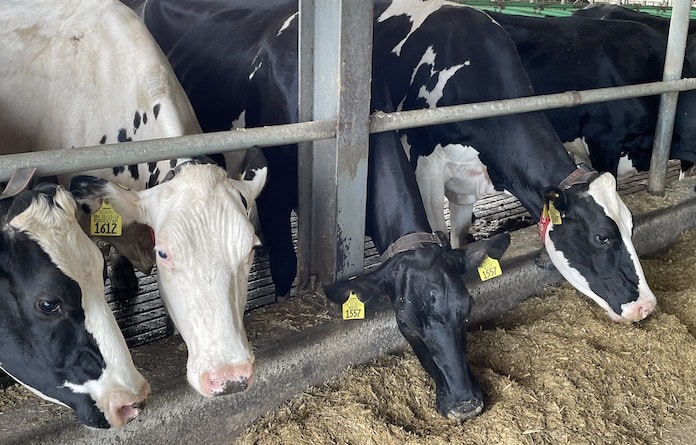Go big or go home: Dairy farmers reflect on industry changes

For the Parkers and the Reinhardts, dairy farming literally runs in their blood.
Both families have witnessed and adapted to changes in the industry over the years.
According to a report by the Economic Research Service/USDA titled “Profits, Costs and the Changing Structure of Dairy Farming,” the number of farms with dairy cows decreased by 88 percent from 1970 to 2006.
Recently, Monroe County lost its last dairy producer with the closure of Westridge Dairy Farm.
Andy Parker, who owns Parker Dairy Farm on the St. Clair County side of Hecker with his father, said he has noticed the number of dairy farms in Illinois fall between when his dad first took over the operations in 1974 to now.
Yet, he noticed the number of cows on the farm increase over the years, another observation backed by the report.
“Basically, there have become less farms, only the farms have become bigger,” Parker commented on the Illinois dairy industry. “The farms have all grown and it’s basically like everything else: you have to go big or go home.”
Parker attributes this decrease in farms to the demanding nature of the work, as well as the inability to easily leave the industry when prices fluctuate.
“It’s a lot of hard work and it’s very labor-intensive. I’m sure that is the biggest reason,” Parker said. “It’s hard to get days off. The cows are here every day and they need to be milked every day, so I imagine the labor is probably the biggest reason and then the next generation not wanting to take over (on other farms).”
Yet, advances in technology have made it so it is possible for both Parker Dairy Farm and Reinhardt Dairy in Red Bud to increase their herd size over the years. Both of the family-owned farms have specialized robots that milk the cows and provide a variety of data on the cows.
As the Republic-Times previously reported, father-son duo David and Josh Reinhardt welcomed these bots to their farm in 2016, while Parker said they installed them on his family farm in 2017.
“Today we have robots (to where) the cow walks into the stall by herself … we give them a treat so then they walk into the stall. Then, the robot will clean the cow, prep the cow and milk the cow. When she’s done it will disinfect her, put like a post-spray on her, and turn her out. It does that all in about 6.5 minutes,” David Reinhardt, the primary owner of Reinhardt Dairy, explained.
These bots allow Reinhardt Dairy to house 240 dairy cows and Parker Dairy Farm to house approximately 200, and milk cows 24/7 while simultaneously prepping other cows.
Because each farm has four robots, they can milk four at a time in just minutes. This is in great contrast to their ancestors’ farming days.
Reinhardt said his parents moved to the current location in 1954, but before that his grandfather and great-grandfather had a couple of cows. He knows his grandfather sold milk and butter generated from the cows, but he is not sure if his great-grandfather sold dairy goods or just used the cows to sustain himself and his family.
During his childhood, he saw his parents gradually bring more cows to the farm – each one being milked by hand. With the help of a milker, they were eventually able to milk two cows at a time.
“When (my parents) moved in 1954, they sold milk. At that time, they probably started with 15-20 cows. By the time I was able to start helping (approximately 50 years ago), they were probably milking 30-35. When I was big enough to carry a bucket, well, I started working.”
Parker’s grandfather started with a tie-stall barn, but over the years the family had two separate buildings, one for a milking parlor and the other a free-stall barn, allowing them to increase the number of cows on their farm.
“They would have another building for laying down and for eating, so basically the milking parlor is only used for milking,” Parker said. “(With this change), you can use the same size building to milk 70-80 cows, whereas before with that building if they stayed there all year, they could only have about 17.”
Parker said the robots the farm introduced in 2017 have further offset the shortage of labor the industry faces, but that is not the only big advantage they bring. By assessing milk quality, the robots can also alarm farmers of any potential illnesses the cows may have.
“Whenever it gets a sample of milk it will check the milk temperature and then that usually reflects the temperature of the cows. You would be able to tell if the cow is running a fever,” Parker explained. “It also detects the quality of milk. If the cow has mastitis it will alarm you of that and therefore we can give the cow the treatment she needs to fight it.”
The only drawback, if one could even call it that, to these machines is they are not invincible.
“It’s like putting your car on the road,” Reinhardt explained. “If you put your car on the road 24 hours a day, sooner or later you’re going to have maintenance … so the robots are kind of the same way.”
As Parker stressed, mechanical issues are rare considering the machine runs 24/ 7, only cropping up “once every couple of weeks.”
“I will definitely take that over getting up at 4 a.m. every day of my life,” Parker chuckled.
Both families also use Fit Bit-esque trackers that help them keep tabs on each cow’s health.
“Pretty much if you want to know anything about the cow, you can look on the computer (that corresponds with the tracker) and it will tell you what her temperature is, how much she weighs, how many minutes she chewed her cud yesterday (and more). It’s pretty mind-blowing how much information it gives you,” Parker explained, later adding, “You can tell if the cow ate less the day before, so (with) that along with other things you can tell maybe she’s getting sick … So, you can maybe nip it in the bud before she actually gets sick, or truly gets sick.”
The trackers can also help farmers determine optimal breeding time.
“If she eats less and is more active, that means she’s usually in heat and it would be time to breed her,” Parker said. “So now we use that (activity monitor) to breed our cows.”
Before the trackers, farmers would rely on observation to determine if a cow needed medical treatment or if she was in heat.
In the busy seasons, breeding before the trackers could resort to a game of chance, Parker said.
“When cows are in heat they try to jump each other and if you were busy out in the field, (but) you may not see them more active and trying to jump each other,” Parker said. “We would typically, just because of labor issues, let a bull run with them in the busier months of the year and then in the wintertime when we would have more time we would artificially (inseminate them). That was 30-40 years ago that we would do it that way, but then in the past 20 years we’ve pretty much been doing only artificial.”
How goods reach the market has also evolved since these farms have been in business.
Parker spoke on how, in the days before refrigeration, his great-grandfather would make daily home deliveries to ensure the milk was fresh. Today, both Reinhardt Dairy and Parker Dairy Farm are involved in the Prairie Farms co-op, so they each own a share of the company depending on how much milk they produce.
“They’ll come every other day to take the milk out of our tank and then they’ll take it to a processing plant where it will either get made into gallon milk, 2 percent whole milk, skim milk or butter or ice cream,” Parker said. “Depending on which plant they take it to is what it gets processed into. We don’t have any say in what they do with it once they take it out of the tank. It’s up to them. (It goes) where they need more milk, basically.”
Parker said his grandfather was one of the first farmers in the area to join the co-op, and since then the number of farms in the co-op has grown exponentially.
Reinhardt said being involved in the co-op was a huge blessing when the pandemic hit. Across the country, headlines such as “Dairy farmers dumping milk amid COVID-19” and “Wasted milk, euthanized livestock: Photos show how coronavirus has devastated US agriculture” became commonplace.
With school and restaurant shutdowns, demand plummeted, with prices following suit.
“A major portion of that went to restaurants, so when the restaurant business closed, that had a major effect on the milk side. That’s still been somewhat of an issue. People did purchase some and it has gained back some, but it took awhile for all the processing plants to retool to make smaller packages and that type of stuff,” Reinhardt explained. “Prairie Farms is pretty heavily into supplying local schools in the area, so when the schools closed and did virtual learning, that had a major effect on (the industry). All of a sudden you don’t make those deliveries, but the milk still needs to go someplace. It doesn’t keep forever.”
Fortunately, Reinhardt and Parker did not suffer such a fate, as the co-op was able to ensure the farms did not have to dump their milk. Reinhardt said he believes the company prevented the highly-perishable dairy products from going to waste by helping supply the USDA Farmers to Families Food Box Program.
Day-to-day operations may have continued as normal during the pandemic, but farmer’s pocketbooks took a big hit.
Reinhardt estimated pay decreased by 30-40 percent, thanks to the low milk prices.
While this is unsettling, Reinhardt and Parker both said such uncertainty comes with the business.
“Farming is a business of peaks and valleys, and so you hope you survive the valley and when the prices get better and peak you hope you’re still surviving. That’s the way farming is,” Reinhardt remarked. “Don’t get me wrong, I’d say the milk price was bad for 3-4 months … maybe a little longer. Now it has gotten back to survival. I wouldn’t say we’re making money, but we’re surviving. That’s not good, but we’re surviving.”
Parker said growing his own feed helped him weather the pandemic storm, as it is a major expense. Of the feed he does purchase, he tries to use by-products to cut costs.
“Our saving grace is that we are able to feed our cows from our own land,” Parker said, later adding, “I always kind of joke that it seems like the price of corn can double in about six months, and I don’t think the price of milk has doubled ever in my lifetime. The price of milk – if anything – doesn’t change a whole lot, the price of grain or crops it’s either feast or famine.”
For information on pandemic-related assistance for farmers, visit USDA’s farmers.gov.






